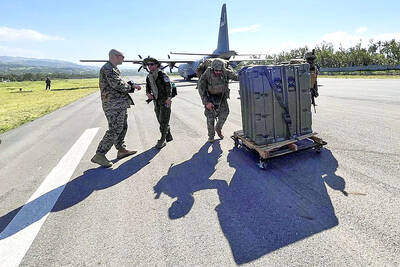Senior intelligence officials have identified the specific Chinese military outfit and technical surveillance unit tasked with cyberwarfare against Taiwan and say it is located on the campus of Wuhan University, in Wuhan, Hubei Province.
They said the Wuhan University-based unit is actually the Sixth Bureau of the People’s Liberation Army (PLA) General Staff Department’s (GSD) Third Department.
The Sixth Bureau is engaged in technical aspects of surveillance and intelligence-gathering on important Taiwanese agencies, intercepting telecommunications signals, hacking computers and mobile phone service networks, and satellite imagery reconnaissance against Taiwan, according to recent statements and interviews with Military Intelligence Bureau (MIB) and Ministry of National Defense (MND) officials.
“China’s espionage activities and intelligence-gathering against Taiwan and other countries is always hidden under the guise of academic research centers, non-profit foundations or private sector companies,” said a ministry official who declined to be named.
“It is the same for the PLA’s GSD Sixth Bureau. Its units have network specialists, computer technicians, analysts and trained hackers working in offices at Wuhan University,” he said.
“These offices are installed on campus under the cover of research centers and telecommunication laboratories,” he said.
Other nations who have come under cyberattack and digital information theft have also reported that Chinese cyberarmy units are operating inside university campuses.
“The aim is to conduct state espionage work under the facade of academic research,” the defense ministry official said.
Foreign and Taiwanese defense experts said the Sixth Bureau is one of the 12 bureaus under the PLA’s GSD Third Department (abbreviated as “3PLA”), whose mandates and functions fall under the framework of technical reconnaissance and digital information warfare.
PLA Unit 61398 in Shanghai’s Pudong District, believed to be responsible for the hacking and theft of business information as well as designing malware attacks against the US and other Western countries, is part of the same agency network under 3PLA’s 2nd Bureau.
The unit gained widespread attention after the US Department of Justice on May 19 last year indicted five PLA officers with conducting economic cyberespionage against US companies, including Westinghouse Electric, US Steel, Allegheny Technologies and Alcoa, as well as the United Steel, Paper and Forestry, Rubber, Manufacturing, Energy, Allied Industrial and Service Workers International Union.
The five men were identified as working for Unit 61398.
Figures compiled by the National Security Bureau and other government departments in Taiwan show that in 2013, the NSB came under Chinese cyberwarfare attack 7.22 million times, the Ministry of Justice’s Investigation Bureau (MJIB) came under 1.56 million cyberattacks and the defense ministry faced 1.01 million attacks.
According to a senior MIB officer, China’s surveillance and espionage activities against Taiwan can be divided into two main areas: human intelligence and signals intelligence.
The human intelligence programs against Taiwan are mostly directed by its Ministry of State Security (also known as guoan, 國安部), along with the United Work Front Department, which is part of the Chinese Communist Party’s Central Committee, the MIB officer said.
These programs are aimed at recruiting or enticing Taiwanese officials and agents for information, the officer said.
However, signals intelligence programs against Taiwan that monitor telecommunications, radar, radio and other signals are under the command of the GSD Third Department, he said.
Additional reporting by staff writer

LOOKING NORTH: The base would enhance the military’s awareness of activities in the Bashi Channel, which China Coast Guard ships have been frequenting, an expert said The Philippine Navy on Thursday last week inaugurated a forward operating base in the country’s northern most province of Batanes, which at 185km from Taiwan would be strategically important in a military conflict in the Taiwan Strait. The Philippine Daily Inquirer quoted Northern Luzon Command Commander Lieutenant General Fernyl Buca as saying that the base in Mahatao would bolster the country’s northern defenses and response capabilities. The base is also a response to the “irregular presence this month of armed” of China Coast Guard vessels frequenting the Bashi Channel in the Luzon Strait just south of Taiwan, the paper reported, citing a

A total lunar eclipse, an astronomical event often referred to as a “blood moon,” would be visible to sky watchers in Taiwan starting just before midnight on Sunday night, the Taipei Astronomical Museum said. The phenomenon is also called “blood moon” due to the reddish-orange hue it takes on as the Earth passes directly between the sun and the moon, completely blocking direct sunlight from reaching the lunar surface. The only light is refracted by the Earth’s atmosphere, and its red wavelengths are bent toward the moon, illuminating it in a dramatic crimson light. Describing the event as the most important astronomical phenomenon

UNDER PRESSURE: The report cited numerous events that have happened this year to show increased coercion from China, such as military drills and legal threats The Chinese Communist Party (CCP) aims to reinforce its “one China” principle and the idea that Taiwan belongs to the People’s Republic of China by hosting celebratory events this year for the 80th anniversary of the end of World War II, the “retrocession” of Taiwan and the establishment of the UN, the Mainland Affairs Council (MAC) said in its latest report to the Legislative Yuan. Taking advantage of the significant anniversaries, Chinese officials are attempting to assert China’s sovereignty over Taiwan through interviews with international news media and cross-strait exchange events, the report said. Beijing intends to reinforce its “one China” principle

The presence of Taiwanese politicians at China’s military parade tomorrow would send the wrong message to Beijing and the international community about Taiwan’s sovereignty and democracy, a national security official said yesterday. China is to hold the parade tomorrow to mark the 80th anniversary of Japan’s surrender in World War II. By bringing together leaders of “anti-West” governments such as Russia, North Korea, Iran and Belarus, the parade aims to project a symbolic image of an alliance that is cohesive and unbending against Western countries, the national security official said, speaking on condition of anonymity. Former Chinese Nationalist Party (KMT) chairwoman Hung Hsiu-chu